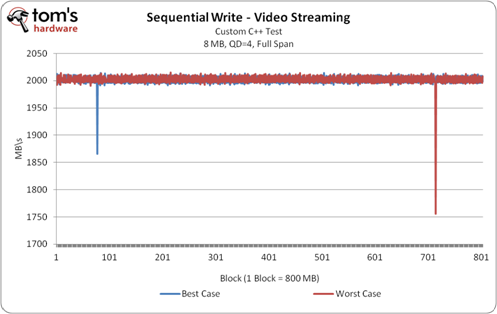Micron RealSSD P320h Review: A PCIe Drive Capable Of 3.2 GB/s
Announced earlier this year, Micron's RealSSD P320h PCI Express-based SSD promises to be an enterprise workhorse. A custom controller, single-level cell NAND, amazingly low latency, stellar random I/O, and incredible endurance combine to blow us away.
Enterprise Video Streaming Performance
Enterprise video streaming is becoming a much more demanding workload within the enterprise space. Companies want more HD streams with higher bit-rates and no stuttering. A storage solution well-suited for enterprise-class video delivery has completely different capabilities than something designed for databases. At the end of the day, you're basically looking for exceptional large-block sequential write performance. You also need a high level of consistency that traditionally isn't seen from consumer SSDs. For a more in-depth analysis, take a look at our Intel SSD 910 review.
As a refresher, once the drive is in a steady state, we write its entire capacity 100 times. We use 8 MB transfer sizes and a queue depth of four, recording timestamps for each individual write. The graph below reflects 100-point averaging so that you can better visualize the results.
Frankly, we were shocked after our first look at the data. So much so, in fact, that instead of our usual 100 full writes, we went all the way up to 250. That's over 160 TB of data written to the P320h, including over 20 million individual 8 MB writes. The graph below shows the best- and worst-case runs out of those 250 iterations.
And that's it. Two minor hiccups, each of which is easy to overcome with a modest buffer. Because we are testing the P320h as a formatted drive, just as you would use it in the real-world, it's impossible to even say what caused those dips. They could have very well been from the driver or operating system doing some periodic check on the hardware. The table below shows how much memory would be required to maintain a given threshold.
| Threshold (MB/s) | Best-Case Buffer Size In MB | Worst-Case Buffer Size In MB |
|---|---|---|
| 1850 | 26 | 53 |
| 1900 | 34 | 66 |
| 1950 | 40 | 79 |
| 2000 | 52 | 92 |
| 2025 | 6310 | 6815 |
These are not normal results, particularly for an SSD. Typically, solid-state storage has issues where, in a very small percentage of writes, the operation takes an order of magnitude longer to complete. This is normally attributed to internal SSD tasks like garbage collection. Because those background operations are inherent and unavoidable, this sort of testing is necessary to measure how the outliers negatively affect streaming performance.
The P320h is such a consistent performer, though, that it needs almost no buffer up to and beyond its rated performance. Normally, when you go beyond the average, the required buffer grows exponentially. But the P320h goes from almost no buffer at 2,000 MB/s, to an unrealistically-high number just 25 MB/s higher.
Based on our maximum latency performance test, these results probably shouldn't come as a shock. But the fact that the consistency held up over such a long period of time certainly surprised us.
Get Tom's Hardware's best news and in-depth reviews, straight to your inbox.
Current page: Enterprise Video Streaming Performance
Prev Page Sequential Performance Next Page Power Consumption-
mayankleoboy1 i dont see this as the future of consumer SSD's, just like a 16 core CPU is not the future of consumer CPU's.Reply -
bawchicawawa mayankleoboy1i dont see this as the future of consumer SSD's, just like a 16 core CPU is not the future of consumer CPU's.Reply
Such an apples to oranges comparison... -
memadmax Eliminating the SAS controller is the logical way to have these pci-e based ssd drives...Reply
Kinda surprised something like this didn't come out first as it makes more sense.... -
mayankleoboy1 bawchicawawaSuch an apples to oranges comparison...Reply
really ? Increasingly, performance is basically dependent on extracting parallelism. Whether in storage or in CPU performance.
Desktop/Mainstream users just dont do so much in parallel that they can fully use all the hardware. -
JOSHSKORN mayankleoboy1i dont see this as the future of consumer SSD's, just like a 16 core CPU is not the future of consumer CPU's.I see a purpose for 16 core processors. How are we going to otherwise be able to run Crysis 6?Reply -
mayankleoboy1 JOSHSKORNI see a purpose for 16 core processors. How are we going to otherwise be able to run Crysis 6?Reply
Use a 5000 core GPU ? -
youssef 2010 ArticleAlthough read performance is out of this world, the RealSSD P320h's write performance isn't nearly as spectacular. That's not to say the drive doesn't do well; it's just not as impressive after looking at those massive read numbers. read performance was out of this world, the write performance wasn't nearly as spectacular. Now, that's not to say that the P320h doesn't perform well, it's just not as impressive as the read resultsReply
????????!!!!!!!!!!! -
abbadon_34 After all these years it's nice to see the OCZ Revo at least mentioned. Considering a bootable PCI-E x4 SSD can be had for under $200 for over 5 years now, and is on it's 4th+ generation, one can only wonder why it's been ignored for so long.Reply -
Marcus52 Micron deserves a pat on the back for this one!Reply
Thanks for the review, love to see this kind of advancement and a peak into the future new hardware brings with it, even if it isn't directly applicable to me at this point in time.
